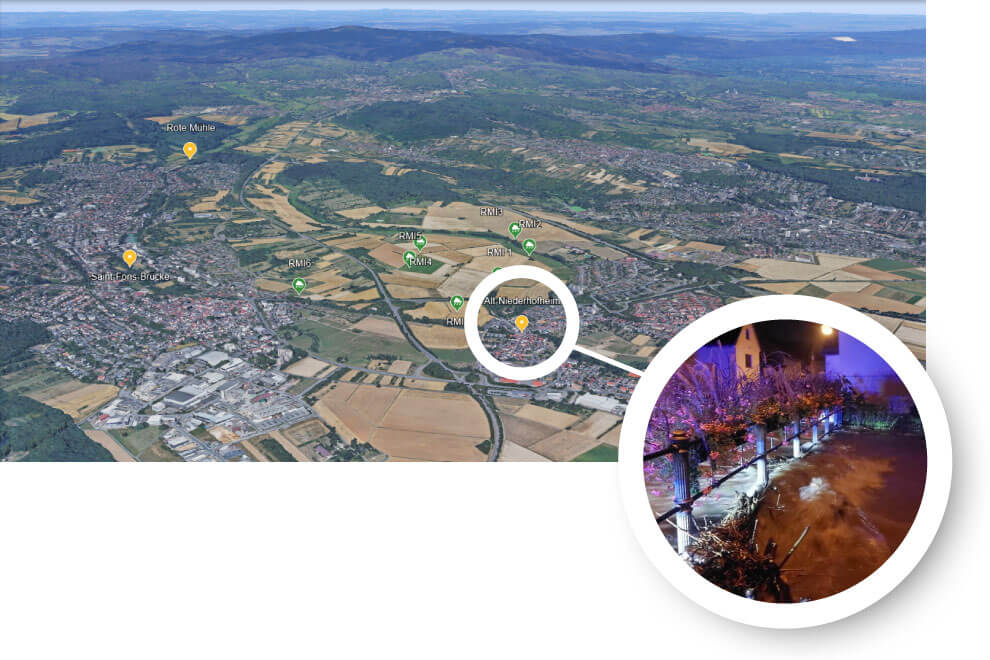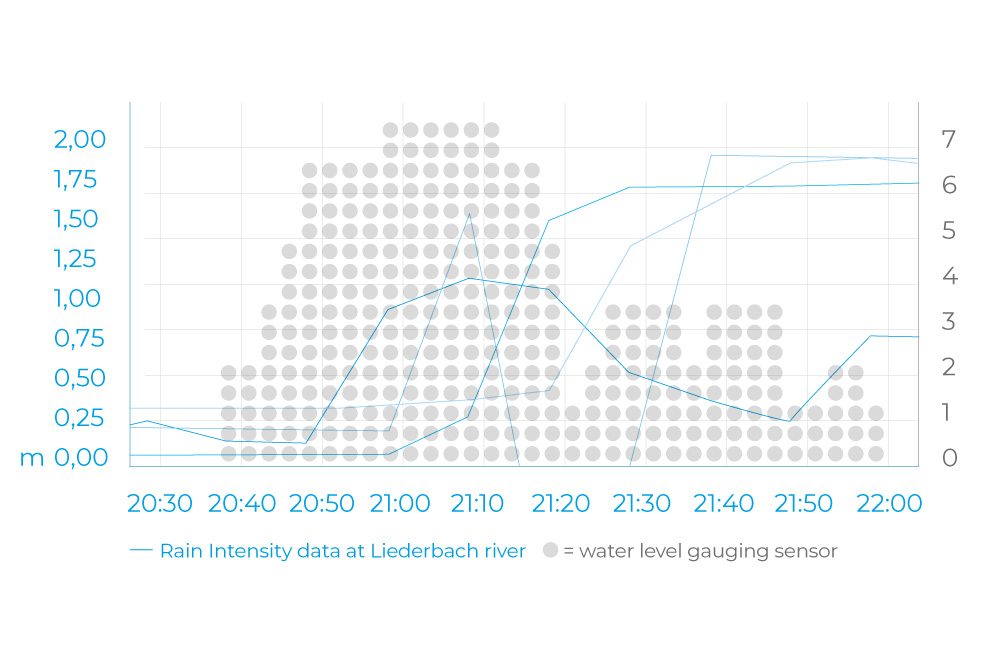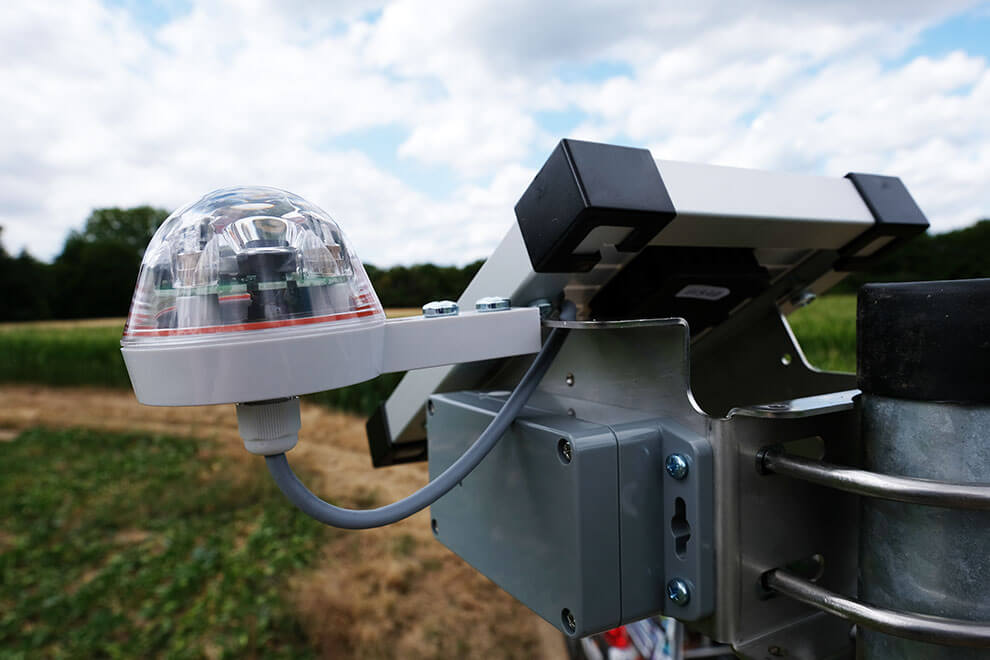Extreme Rainfall Event in August 2023
Liederbach am Taunus
Background
Liederbach am Taunus, a town with 9,000 inhabitants in Germany has had to contend with extreme heavy rainfall events in recent years, which have resulted in flooding in the local stream, Liederbach. This otherwise calm and dry stream, a tributary of the river Main, turns into a menacing flood path during extreme heavy rainfall events. On 16 August 2023, such an extraordinary devastating event significantly affected the lives of the town residents and put the community’s resilience to the test.
As reported by dw.com (also daswetter.com), more than 25,000 lightning strikes were observed in one hour, which is twice as many as in the entire year of 2022 in Hessen. Around 65 mm of rainfall occurred in just 2 hours, which was the entire average monthly rainfall amount for August in the region. The case study of the heavy rainfall event on the 16th of August, 2023. in Liederbach am Taunus outlines the correlation between the rainfall data from the rain sensor network and the river water level data.
Study area and data
Eight NIVUS RMI optical rainfall sensors and four water level sensors have been installed for the testing phase of the pilot project. The rain sensor network is distributed such a way that the maximum distance between the sensors is 1.3 km.
The rainfall sensors provide rainfall intensity data qualitatively with different levels from no rain at all to violent rainfall. The distance between the water level sensor installed on the most upstream section and the downstream station, namely, Liederbach Town Hall, is around 6 km.


Data analysis and insights
Rainfall Data Analysis
Despite a relatively low distribution of the rain sensors in the region, the combined analysis of all rain sensors showed promising results. As the rain started around 20:37, the rainfall intensity gradually increased and eventually led to the ›Violent‹ rain event. The rainfall intensity with extremely heavy rain lasted about 30 minutes from 20:48 to 21:16. The maximum rainfall event lasted around 17 minutes. This storm reportedly spread throughout the region, causing flooding and massive disruption to the city and the public transportation.
Rainfall to runoff obersvation
The hydrograph of the four water level sensors displays the sudden rise in the river immediately after the heavy rain event (fig.2). Within 30 minutes of the start of the intensive rain, the water level at the downstream station of Liederbach Town Hall Rathaus rose from 0.089 m to 1.557 m (almost 1600 % increase). Located upstream, the Alt Niederhofheim bridge was flooded and obstructed by the massive wood debris as well as another station in the neighoring Kelkheim. The water level peaks there were seen as early as 21:10 when the violent rainfall had lasted for around 15 minutes. More rainfall events in the upstream region could have influenced this rise in water levels and the peak values.
»On the day of the heavy rain, the rain and water level sensors played a crucial role by collecting essential data, which, although not immediately used for forecasting, laid the foundation for future preparations. While we consider expanding our sensor network, the readings from these sensors during the event confirm our ambition to integrate AI for more accurate and proactive predictions. The journey begins with reliable sensors, and the planned route promises a future where technology anticipates weather patterns before they arrive.«
Alexander Rempt
Community Liederbach am Taunus (Digitalization / IT)
Implications and what it means for NIVUS RAIN
1. Early warning system
If distributed over several catchment areas on a large scale, the rainfall sensor network can capture the realtime rainfall data. Those in combination with public weather information and a dedicated AI lead to a highquality heavy rain forecast. The sensitive and vulnerable zones could be defined as the focus of the early warning system, giving the responsible authorities and emergency services sufficient time to prepare for such extreme rainfall events up to 60 minutes before the actual rain event. From this event in Liederbach, the massive flooding was observed about 30 minutes after the start of the rain event in the affected catchment area.
2. Advantage of service provided
NIVUS RAIN is provided to users as a digital service, built on a sensor and cloud network maintained by NIVUS and its operators. In spite of the advances in non-contact water level monitoring, there is always a possibility that the sensors installed on the ground will be flooded or hindered by debris, as observed at Alt Niederhofheim and Liederbach Town Hall. In such cases in the future, a flood would have caused massive destruction, by the time the water level sensors are back in operation. The RMI rainfall sensors, on the other hand, are not only maintenance-free but also strategically distributed in dense swarms and installed above the ground. This design provides a significant advantage over traditional measurement systems, ensuring the detection of even the most catastrophic events without any oversight.
Key takeaways
Although the rainfall sensor network is only distributed on a small scale in the pilot phase, the relationship between the rainfall and water level increase is clearly visible. As evident from the study, such heavy rain events are detrimental to causing unprecedented flooding and damage in urban areas and even on typically dry rivers. With a well-planned and expanded network of rain sensors with wider coverage, the NIVUS RAIN system could fulfil its high potential as an effective Early Warning System for the following purposes:
- Predict heavy rainfall events up to 60 minutes before they occur.
- Provide a cost-effective solution that is easy for the end customer to implement.
- Apply advanced, innovative Artificial Intelligence (AI) technology to improve disaster preparedness for the rescue force, city authorities and the citizens.
- Timely provision of complementary high-quality information that can be used to improve the protection of valuables and lives.
For more information please contact:
Alexander Buddrick
Business Development
Phone: +49 (7262) 9191 802
Mobile: +49 (160) 47 88 136

